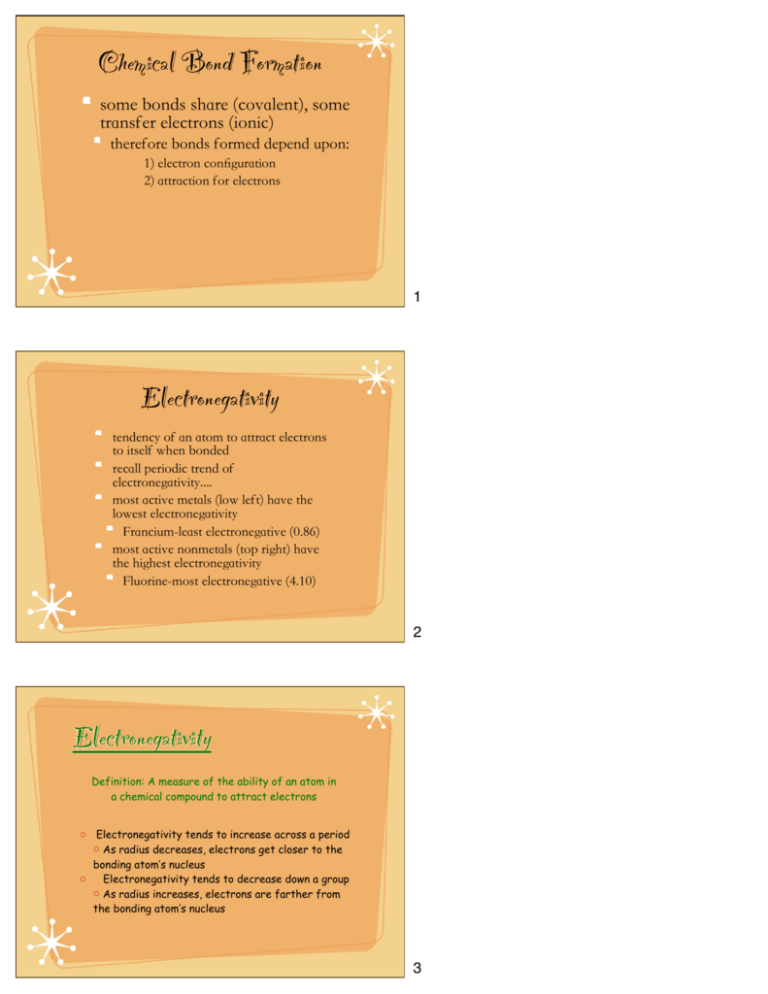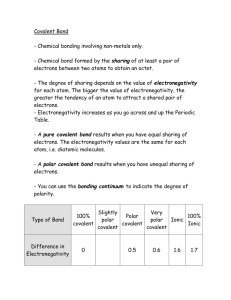File
advertisement

Chemical Bond Formation some bonds share (covalent), some transfer electrons (ionic) therefore bonds formed depend upon: 1) electron configuration 2) attraction for electrons 1 Electronegativity tendency of an atom to attract electrons to itself when bonded recall periodic trend of electronegativity.... most active metals (low left) have the lowest electronegativity Francium-least electronegative (0.86) most active nonmetals (top right) have the highest electronegativity Fluorine-most electronegative (4.10) 2 Electronegativity Definition: A measure of the ability of an atom in a chemical compound to attract electrons o Electronegativity tends to increase across a period o As radius decreases, electrons get closer to the bonding atom’s nucleus o Electronegativity tends to decrease down a group o As radius increases, electrons are farther from the bonding atom’s nucleus 3 Periodic Table of Electronegativities 4 Periodic Trend: Electronegativity 5 Summary of Periodic Trends 6 try these... Arrange the following elements in order of increasing electronegativity 1. antimony, fluorine, indium, selenium A: indium, antimony, selenium, fluorine 2. francium, gallium, germanium, phosphorus, zinc A: francium, zinc, gallium, germanium, phosphorus 7 Electronegativity The greater the difference in electronegativities (Δ), the greater the strength of the bond between atoms Bond strength-measure of energy needed to break bond between atoms greater bond strength, the more energy required to break the bond 8 Electronegativity H-F Bond Strength (kJ/mol) 568.1 1.90 H-Cl 431.95 0.63 H-Br 366.25 0.54 H-I 298.32 0.01 Bond Δ 9 Bond Character electrons are transferred when electronegativity difference is high electrons are shared when electronegativity difference is low At what point does sharing switch to transferring? 1. electronegativity varies slightly depending on atoms in bond 2. number of atoms not an easy answer..it is a continuum 10 Bonding Character Ionic Bonds atoms combine via TRANSFER of electrons ions are produced and attraction of opposite charges holds compounds together Δ≥ 1.67 the large electronegativity difference means one atom pulls electron(s) completely away from the other atom Covalent Bonds atoms combine via SHARING of electrons no ions are produced and sharing electrons holds compounds together Δ< 1.67 the small electronegativity difference means neither atom pulls electrons completely away; they share 11 Bond Character To determine which type of bond: 1. Find Δ = |electronegativity of atom 1 electronegativity of atom 2| 2. Classify the bond; 1.67 or higher = ionic; less than 1.67 = covalent Mg-O Δ = |3.50-1.23|= 2.27 ionic B-N Δ = |3.07-2.0|=1.06 covalent 12 Try this: Calculate Δ and classify the following bonds as ionic or covalent based on electronegativity differences B-P Hydrogen-Iodine Be-Si Astatine-Beryllium C-Na Cobalt-Fluorine Li-O Chlorine-Tellurium Mg-N Bromine-Cerium 13 Ionic Bonds/Ionic Compounds ex. NaCl Δ = |1.01-2.83| = 1.82 Characteristics: 1. high melting points (MP) 2. conduct electricity in molten state 3. soluble in water 4. crystallize as sharply defined particles Occur between a metal and nonmetal, so we do not have to find Δ every time 14 15 Ionic Bonding 16 Electron Dot Notation 17 Ionic Bonding with Lewis Dot Diagrams Show how the compound MgO is formed using Lewis Dot Diagrams Try KF 18 Covalent Bonds atoms with the same or nearly the same electronegativity (low Δ) react by sharing electrons Characteristics 1. usually occur between atoms of nonmetals 2. typically have low MP 3. do not conduct electricity 4. can be brittle or gases Occur between a nonmetal and nonmetal (or metalloids), so we do not have to find Δ every time 19 Covalent compounds tend to form so that each atom, by sharing electrons, has an octet of electrons in its highest occupied energy level. Covalent compounds involve atoms of nonmetals only. The term “molecule” is used exclusively for covalent bonding 20 Covalent Bonds 21 Covalent Bonding with Lewis Dot Diagrams Covalent bonds result from the sharing of electrons Using Lewis Dot Diagrams, show how bonding occurs between a fluorine molecule, F2 Show how the bonding occurs in water, H2O 22 Completing a Lewis Structure -CH3Cl Make carbon the central atom (it wants the most bonds, 4) Add up available valence electrons: Join peripheral atoms to the central atom with electron pairs. H C .. .. .. .. H .. .. H C = 4, H = (3)(1), Cl = 7 Total = 14 Cl .. Complete octets on atoms other than hydrogen with remaining electrons 23 Covalent Naming There are 7 elements commonly found in nature as diatomic molecules - made of two atoms of the same element hydrogen molecule - H2 nitrogen molecule - N2 oxygen molecule - O2 fluorine molecule - F2 chlorine molecule - Cl2 bromine molecule - Br2 iodine molecule - I2 24 Covalent Prefixes Often the final vowel of the prefix is dropped if the element name begins with a vowel subscript # 1 2 3 4 5 6 7 8 9 10 prefix monoditritetrapentahexaheptaoctanonadeca- 25 Covalent Naming Follow the order of the chemical formula Name the first element using the exact element name Name the second element as though it is an anion (stem with the -ide ending, oxide) add Greek prefix to each element name to denote subscript mono is usually NOT used, unless we have to differentiate between two compounds of the same elements 26 Covalent Naming Given the following formulas of covalent compounds, identify the correct name N2O3 first element name: nitrogen second element name with -ide ending: oxide add prefixes: dinitrogen trioxide P4O6 27 Naming Binary Compounds P2O5 = diphosphorus pentoxide CO2 = carbon dioxide CO = carbon monoxide N2O = dinitrogen monoxide 28 Compound Name Carbon dioxide Carbon monoxide Diphosphorus pentoxide Dinitrogen monoxide Silicon dioxide Carbon tetrabromide Sulfur dioxide Phosphorus pentabromide Iodine trichloride Nitrogen triiodide Dinitrogen trioxide Compound Formula 29 Answers – Write the Formula Compound Name Carbon dioxide Carbon monoxide Diphosphorus pentoxide Dinitrogen monoxide Silicon dioxide Carbon tetrabromide Sulfur dioxide Phosphorus pentabromide Iodine trichloride Nitrogen triiodide Dinitrogen trioxide Compound Formula CO2 CO P2O5 N2O SiO2 CBr4 SO2 PBr5 ICl3 NI3 N2O3 30 Practice – Name the Compounds Compound Formula N2O4 SO3 NO NO2 As2O5 PCl3 CCl4 H2O SeF6 Compound Name 31 Answers – Name the Compounds Compound Formula N2O4 SO3 NO NO2 As2O5 PCl3 CCl4 H2O SeF6 Compound Name dinitrogen tetroxide sulfur trioxide nitrogen monoxide nitrogen dioxide diarsenic pentoxide phosphorus trichloride carbon tetrachloride dinitrogen monoxide selenium hexafluoride 32 Covalent Naming Try to determine the names of these covalent compounds: N2O4 Cl2O6 SF4 CO CO2 33 Covalent Naming Write the formula of the following covalent compounds from their name disulfur trichloride tetraphosphorus trisulfide carbon disulfide sulfur trioxide 34 Polarity and Covalent Bonds In a covalent bond between different elements, one element attracts the shared pair of electrons more strongly than does the other This creates a polar-covalent bond The atom with the higher electronegativity attracts electrons more strongly and acquires a slight/partial negative charge (δ-), leaving the opposing end with a slight/partial positive charge (δ+) 35 Polarity and Covalent Bonds δ+H Examples δ- Nδ O H δ+ H H δ+ δ+ δ- F H - H+ δ δ+ 36









